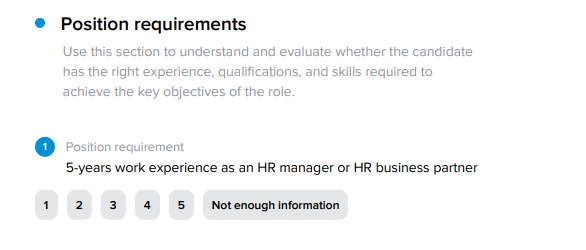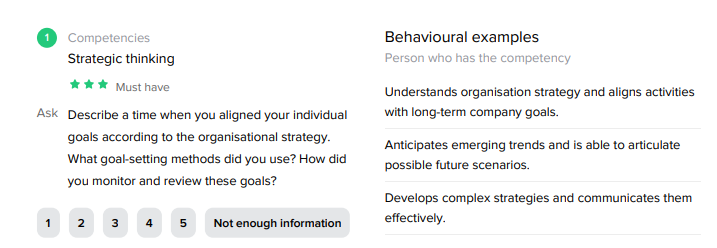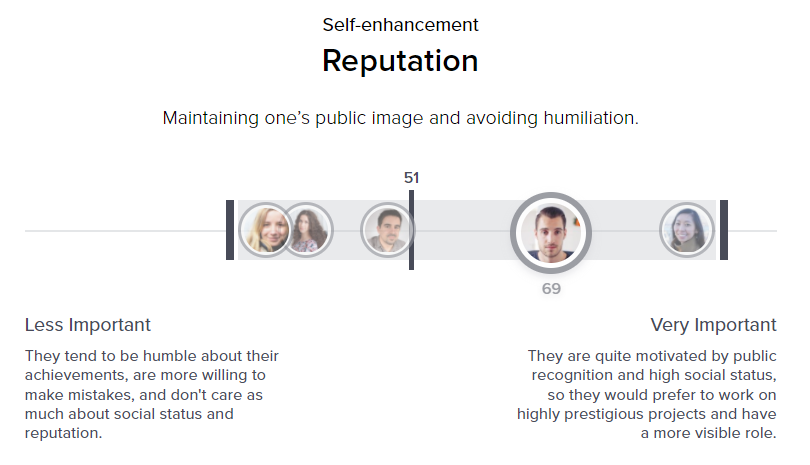How to use Wisnio Hiring Scorecards
Wisnio Hiring Scorecards help you make better hiring decisions by giving you a ready-made Success Profile and actionable insights into interviewing and evaluating candidates.
Ott Niggulis
Think of Scorecards as a position roadmap. They guide the hiring process by clearly defining the skills, experiences, qualifications, knowledge, and abilities needed to succeed in a given role.
As each company is different, use the scorecards as a starting point and adjust the evaluation criteria and competency profile based on your specific requirements.
Without further ado, let’s take a closer look at a scorecard and how to use them.
Step I - Understand the position

Example Position Requirement from a Wisnio Hiring Template
The first step is to understand the position and what it takes to be successful, along with the overall profile of candidates.
Familiarise yourself with the hiring template. There is a lot of information there, and it’s critical you understand all aspects of the template as you’ll be evaluating candidates based on the information within it.
All Wisnio Hiring Scorecards consist of three sections:
Key objectives - a description of the key objectives a candidate should accomplish to be considered successful;
Position requirements - the experiences and qualifications required to accomplish those objectives;
Competencies - the knowledge, skills, and abilities required to perform the job successfully.
All three are vital to successful hiring - each section solves a small piece of the puzzle, and together they form a detailed roadmap.
If you’re still not quite sure about the position after going through the template, your best bet is to talk with people who either work or have worked at similar positions. They can give you insights and points of view that are hard to come by independently.
Once you feel confident you understand the position thoroughly, proceed to the next step - adjusting the template.
Step II - Adjust the template to your needs
No two companies are ever truly the same. They have different needs and wants depending on their strategy and the resources available for them.
We have put our best research and knowledge into the Hiring Scorecards, but changes based on your business reality are inevitable.
It’s important to understand that all elements in the Hiring Scorecards are connected and support each other. Thus, adding or deleting an aspect of it will most probably lead to changes in other parts of the template.
For example, when you add a new objective, make sure that the position requirements and the competencies section include the experiences, skills, knowledge, and abilities needed to achieve that new milestone.
When you feel confident that the template reflects your business reality, you can move forward and actually start hiring.
Step III - Finding candidates
There are many ways to find candidates, from job advertisements to direct search and sourcing on LinkedIn, among others.
The main thing to remember is to use the requirements from the template during the candidate search process. The Scorecards are designed to be used throughout the hiring process.
When using jobs ads, use the position requirements from the template in the job ad.
A requirement for having a bachelor’s degree in marketing is not productive, but a proven ability to develop a clear product positioning strategy is as clear as it gets.
For more on improving the hiring process, read our article on it.
Step IV - The hiring interview

Example interview questions from a Wisnio Hiring Template
The objective of the interview is to gather unique information not found anywhere else that is relevant for evaluating candidates. As free-flowing conversations rarely lead to information needed for making an informed decision, our strong recommendation is to plan the interview ahead of time.
All Wisnio Hiring Scorecards come with ready-made interview questions and evaluation sheets based on:
key objectives;
position requirements;
and needed competencies.
Print out the Hiring Scorecard and use it to guide the interview, ask questions, make notes, and score the candidates.
Use the same questions and scoring criteria for all candidates. Keeping interviews consistent enables you to later compare and contrast candidates in a bias-free and data-based manner.
General pointers for a productive candidate interview:
Focus on facts and past behaviours - Avoid asking questions about opinions of hypothetical situations. Instead, focus on factual achievements and examples of past performance in a similar situation.
Ask follow-up questions - Dig deeper into each situation by asking 2-3 follow-up questions like “What was your specific role in the project?” and “What was the final outcome and how did you measure success?”.
Use the included scorecard - Write down your interview notes and ratings either during the interview or immediately after. To avoid groupthink, it’s essential to do that before discussing the candidate with other interviewers.
Understand team fit with Wisnio

On their own, Hiring Templates Scorecards include everything you need to start hiring high-performing candidates.
What a static template can’t do, is give you insights into a candidate's deep-level characteristics and motivations or evaluate their fit into the existing team. This is where Wisnio comes in.
At Wisnio, we use behavioural science and machine learning technology to give you objective insights into individuals' deep-level characteristics and motivations.
Our decision tools achieve this via a quick 20-minute self-assessment on competencies, personality, and values. The result is a Candidate Profile with insights into candidate behavioural characteristics, competencies, and values.

Example Candidate Profile on Wisnio
On the team side, comparison and benchmarking of the Candidate Profile happens against a Team Profile with actionable insights that guide hiring managers through critical hiring and development decisions.
Using Hiring Scorecards with Wisnio allows you to access candidate-specific data that is hard to come by otherwise.
Understanding the deep-level characteristics and motivations behind candidate actions give you better insights and create an understanding of how one candidate or another could fit into the existing team.
In short, The Wisnio platform helps leaders:
Better manage the hiring process. Use position-specific Hiring Dashboard(s) with candidate management, interview & talent assessment, and candidate comparison built-in.
Independently evaluate candidate competencies and run behavioural tests for personality and value-fit.
Understand team fit and conduct in-depth interviews with candidate-specific questions.
Compare talent assessment results from multiple stakeholders.
Get new hires up-to-speed faster with data-derived insights on the team’s strengths, drivers, and working preferences.
Bring clarity to the most complex hiring decisions and processes.
Conclusions
Wisnio Hiring Scorecards give you a detailed roadmap with everything you need to hire into critical roles.
You get a Success Profile with a description of all the necessary skills, experiences, qualifications, knowledge, and abilities needed to succeed in a given role.
We’ve worked hard to make the scorecards easy to follow and use. Using them comes down to four easy to follow steps:
Deeply understand the position
Adjust template as needed
Find the right candidates
Conduct structured hiring interviews based on the Position Template
To get the most from the templates, we recommend using them with our decision tools that add a layer of team analysis and candidate-team fit critical to building high-performing teams.